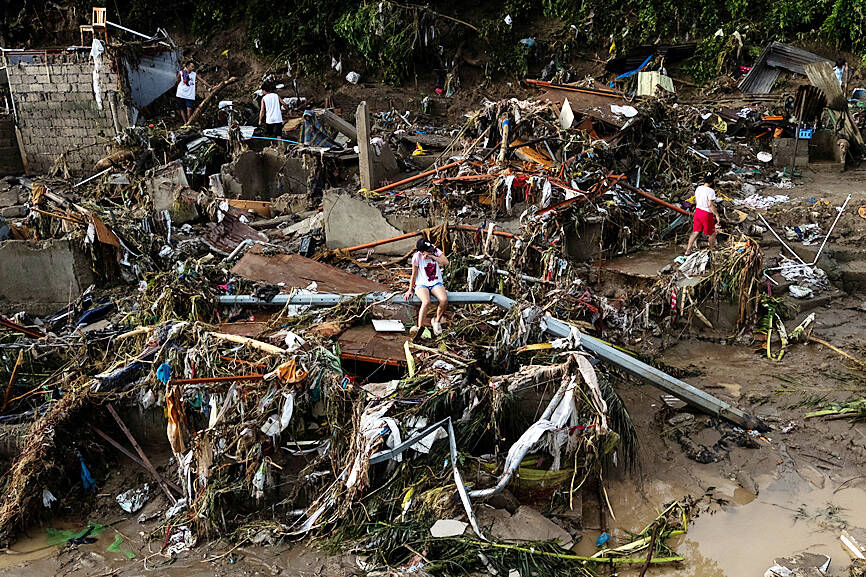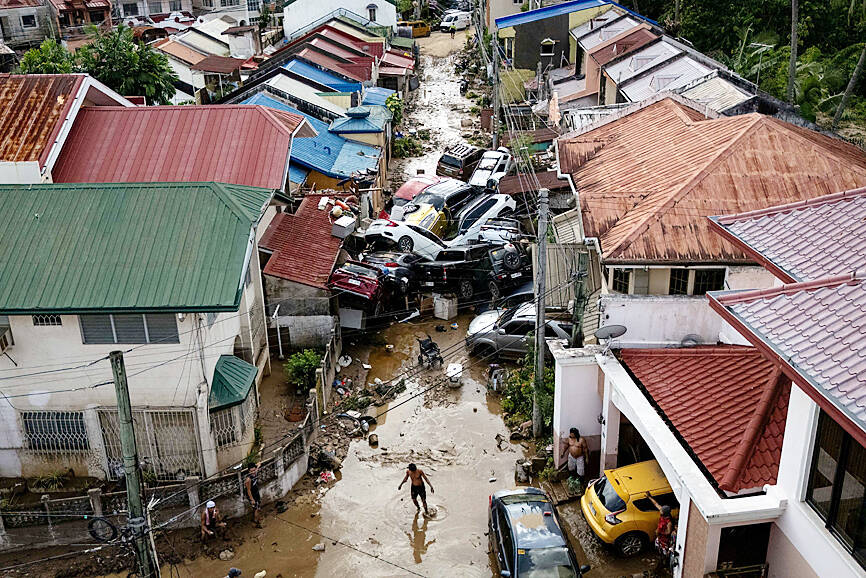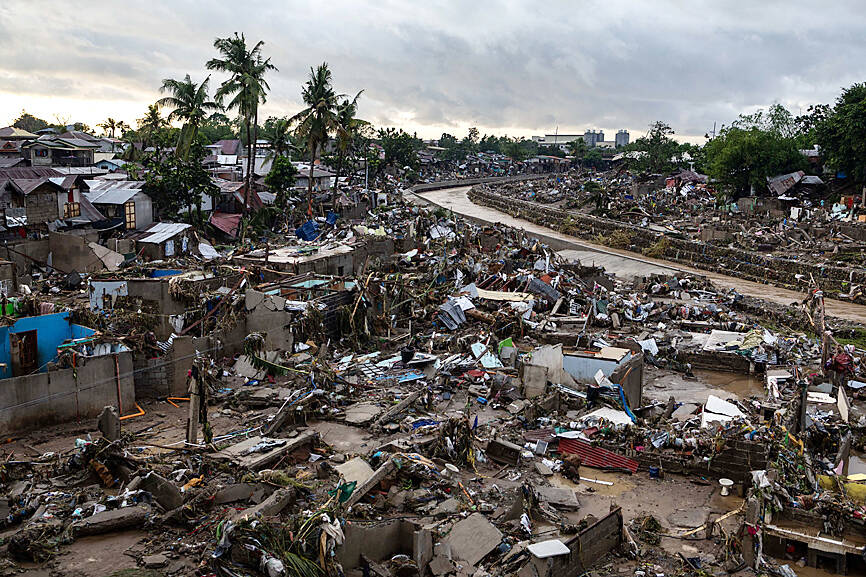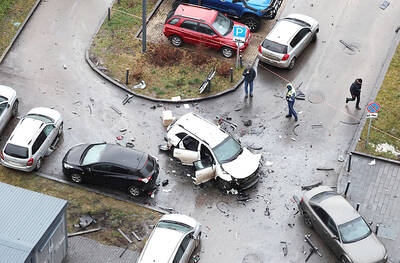The death toll from Typhoon Kalmaegi in the central Philippines yesterday climbed past 100 as the devastating impact on Cebu province became clearer after the worst flooding in recent memory.
Floodwaters described as unprecedented had rushed through the province’s towns and cities a day earlier, sweeping away cars, riverside shanties and even massive shipping containers.
Cebu spokesman Rhon Ramos said that 35 bodies had been recovered from flooded areas of Liloan, a town that is part of the metro area of the provincial capital, Cebu City.

Photo: Reuters
The grim news brought the toll for Cebu to 76, while on neighboring Negros Island, at least 12 people were dead and 12 more were missing after Kalmaegi’s driving rain loosened volcanic mudflow, which buried homes in Canlaon City, police Lieutenant Stephen Polinar said.
“Eruptions of Kanlaon volcano since last year deposited volcanic material on its upper sections. When the rain fell, those deposits rumbled down onto the villages,” he said.
Only one Negros death had been included in an earlier government tally of 17 deaths outside Cebu.

Photo: Reuters
That figure included six crewmembers of a military helicopter that crashed while on a typhoon relief mission.
“Around four or five in the morning, the water was so strong that you couldn’t even step outside,” Reynaldo Vergara, 53, said yesterday, adding that everything in his small shop in Mandanaue had been lost when a nearby river overflowed.
“Nothing like this has ever happened. The water was raging,” he said.

Photo: Reuters
In nearby Talisay, where an informal settlement along a riverbank was washed away, 26-year-old Regie Mallorca was already at work rebuilding his home.
“This will take time because I don’t have the money yet. It will take months,” he said as he mixed cement and sand atop the rubble.
The area around Cebu City was deluged with 18.3cm of rain in the 24 hours before Kalmaegi’s landfall, well over its 13.1cm monthly average, weather specialist Charmagne Varilla said.
Cebu Governor Pamela Baricuatro on Tuesday called the situation “unprecedented” and “devastating.”
Nearly 800,000 people were moved from the typhoon’s path.
The catastrophic loss of life in Cebu comes as the public seethes over a scandal involving so-called ghost flood-control projects believed to have cost taxpayers billions of dollars.
“You begin to ask the question why we’re having terrible flash floods here when you have 26.6 billion pesos [US$452.32 million] for flood control projects” in the national budget, Baricuatro said in an interview with local outlet ABS-CBN.
“Definitely we have seen projects here ... that I would say are ghost projects,” she said.

A car bomb killed a senior Russian general in southern Moscow yesterday morning, the latest high-profile army figure to be blown up in a blast that came just hours after Russian and Ukrainian delegates held separate talks in Miami on a plan to end the war. Kyiv has not commented on the incident, but Russian investigators said they were probing whether the blast was “linked” to “Ukrainian special forces.” The attack was similar to other assassinations of generals and pro-war figures that have either been claimed, or are widely believed to have been orchestrated, by Ukraine. Russian Lieutenant General Fanil Sarvarov, 56, head

SAFETY FIRST: Double the number of police were deployed at the Taipei Marathon, while other cities released plans to bolster public event safety Authorities across Taiwan have stepped up security measures ahead of Christmas and New Year events, following a knife and smoke bomb attack in Taipei on Friday that left four people dead and 11 injured. In a bid to prevent potential copycat incidents, police deployments have been expanded for large gatherings, transport hubs, and other crowded public spaces, according to official statements from police and city authorities. Taipei Mayor Chiang Wan-an (蔣萬安) said the city has “comprehensively raised security readiness” in crowded areas, increased police deployments with armed officers, and intensified patrols during weekends and nighttime hours. For large-scale events, security checkpoints and explosives

PUBLIC SAFETY: The premier said that security would be tightened in transport hubs, while President Lai commended the public for their bravery The government is to deploy more police, including rapid response units, in crowded public areas to ensure a swift response to any threats, President William Lai (賴清德) said yesterday after a knife attack killed three people and injured 11 in Taipei the previous day. Lai made the remarks following a briefing by the National Police Agency on the progress of the investigation, saying that the attack underscored the importance of cooperation in public security between the central and local governments. The attack unfolded in the early evening on Friday around Taipei Main Station’s M7 exit and later near the Taipei MRT’s Zhongshan

REBUFFED: In response to Chinese criticism over recent arms sales, Washington urged Beijing to engage in meaningful dialogue instead of threats and intimidation Washington’s long-term commitment to Taiwan would not change, the US Department of State said yesterday, urging Beijing to stop pressuring Taiwan and engage in meaningful bilateral dialogues. The remarks came in response to a backlash from Beijing about Washington’s latest approval of arms sales to Taiwan. The US Defense Security Cooperation Agency said in a statement on Wednesday that the Taipei Economic and Cultural Representative Office in the US has asked to purchase an arms package, including Tactical Mission Network Software; AH-1W helicopter spare and repair parts; M109A7 self-propelled howitzers; HIMARS long range precision strike systems; tube-launched, optically tracked, wire-guided missiles; Javelin